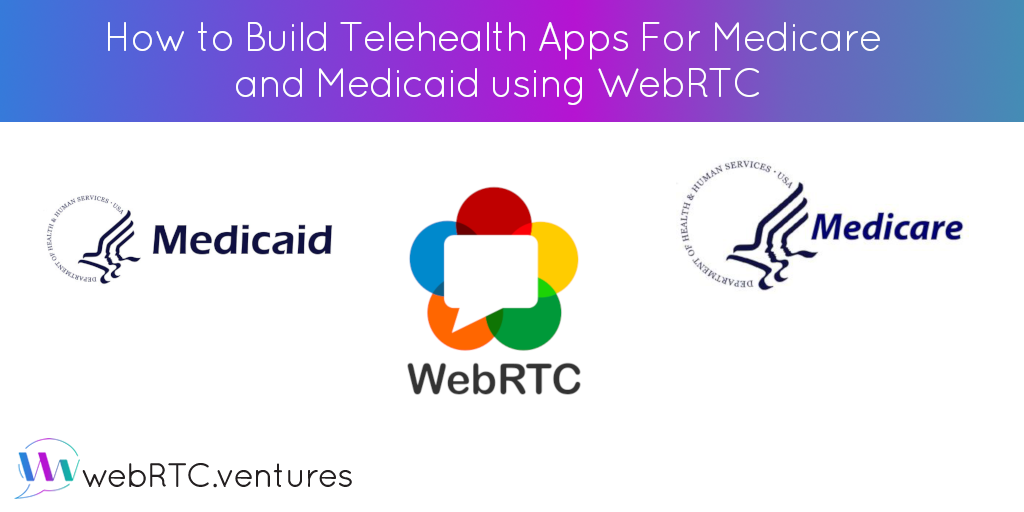Telehealth is a cost-effective alternative for delivering health services. Currently both federal and state healthcare programs already include some level of support for it, however its implementation is not quite straight forward. That’s why today we share our thoughts on how to build Telehealth apps for Medicare and Medicaid using WebRTC.
Core Concepts
First, rules are constantly changing so it’s very important to keep an eye on the official information. Fortunately, both programs provide useful links to stay updated.
Medicare pays for a limited number of Part B services. These services are performed by an enrolled practitioner in a distant site to an eligible beneficiary in an originating site via a telecommunications system. The complete lists of covered services can be consulted using above links.
This interaction between the provider of the service and the receiver substitutes an in-person encounter, and it is billed in the same way.
Distant Site is the location of the practitioner at the time the service is provisioned. Such location must be the same provided at enrollment.
Originating site is the location of the patient. In order to be eligible for Medicare coverage, such location should be either a county outside of a Metropolitan Statistical Area (MSA) or a rural Health Professional Shortage Area (HPSA) within a rural census tract.
Some examples of originating sites authorized by law are physicians’ offices, hospitals and rural health clinics. The complete list can be consulted in above links.
Providers claim for the services as usual, the only difference is that they need to add the proper modifier to the service code, to indicate that it was provided remotely. This applies for both Distant Site services and Originating Site facility fee.
Medicaid rules vary from state to state, so the first step is to review your state’s regulations. However, in general, most of the states that cover remote services behave similar to Medicare so above concept also applies.
The Role of WebRTC
As a condition of payment, connection between provider and beneficiary must be made through an interactive audio and video telecommunication system that permits real-time communication.
In this regard, one of the first ideas that may come to mind is to use Skype or Facetime to deliver your health services. While this may sound like a good idea, there are a few issues that make such applications ineligible for delivering Telehealth services.
The first one is that these applications, at least the free version, is not HIPAA-compliant. What this means is that you can’t guarantee that the information that is being transmitted is secured properly.
This also means that software vendors won’t sign a Business Associate Agreement (BAA), a document that is required when dealing with electronic Protected Health Information (ePHI).
HIPAA compliance requires that the data is encrypted both while it is being transmitted and when it is stored. It also needs a mechanism to define who, when and how can access such information.
Lastly, these applications are designed for social communication only, therefore they lack features that a complete telehealth app requires, such as scheduling capabilities and appointment reminders.
WebRTC is an open technology that provides audio and video communication capabilities to browsers and mobile devices. It can be used in conjunction with other technologies to develop a telehealth app that is HIPAA-compliant and includes the required features to successfully deliver healthcare services.
Two examples of this are UniCustomerCare, our solution to deliver telehealth services, and UniWellness, our student mental healthcare platform. Besides basic video conferencing capabilities, they cover many of your back-office tasks. In addition, both are HIPAA-compliant which guarantees that patient’s data is well secured.
Conclusion
When building a Telehealth application for Medicare and Medicaid, it’s important to take into consideration both the environment on which such application is going to be executed, and the requirements that must fulfill.
WebRTC provides the capabilities required by CMS for billing Telehealth services, and in conjunction with other technologies it can be used to develop a complete application that works on both Distant and Originating sites.
Think a Telehealth Solution may be right for your healthcare business? Need help in determining which option best meets your needs?
We can help you decide whether you want to build a custom telehealth application or want to enable a telehealth starter kit that already includes the most common features our clients need, and which can be licensed, customized, and rebranded for your unique medical or mental health practice. Contact us today.











